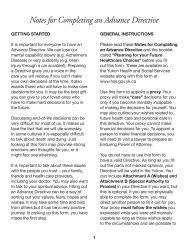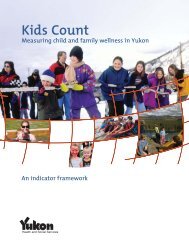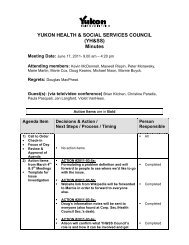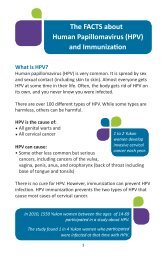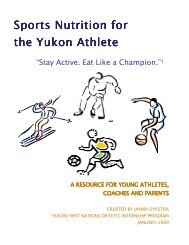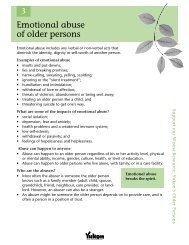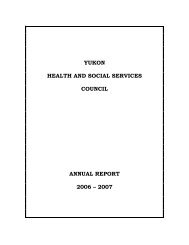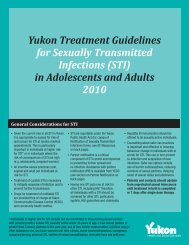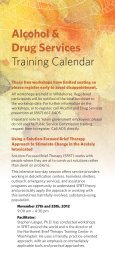Principles of Immunology - Health and Social Services
Principles of Immunology - Health and Social Services
Principles of Immunology - Health and Social Services
Create successful ePaper yourself
Turn your PDF publications into a flip-book with our unique Google optimized e-Paper software.
Community Nursing<br />
Yukon Immunization Program<br />
Section 14 - <strong>Principles</strong> <strong>of</strong> <strong>Immunology</strong><br />
2011 March<br />
SECTION 14 - PRINCIPLES OF IMMUNOLOGY<br />
TABLE OF CONTENTS<br />
1.0 THE IMMUNE SYSTEM............................................................................................ 1<br />
1.1 INTRODUCTION ....................................................................................... 1<br />
1.2 CELLS OF THE IMMUNE SYSTEM .......................................................... 1<br />
1.3 LYMPHATIC SYSTEM .............................................................................. 1<br />
1.4 TYPES OF IMMUNITY (SEE FIGURE 3) .................................................. 2<br />
1.5 ACTIVE IMMUNITY ................................................................................... 4<br />
1.6 INNATE IMMUNITY - “FIRST” IMMUNE DEFENCE ................................. 4<br />
1.7 ADAPTIVE IMMUNITY - “SECOND” IMMUNE DEFENCE ........................ 6<br />
1.8 ADAPTIVE IMMUNITY - CELL MEDIATED IMMUNITY ............................ 6<br />
1.9 ADAPTIVE IMMUNITY - HUMORAL IMMUNITY ...................................... 7<br />
1.10 ANTIBODIES ............................................................................................. 8<br />
1.11 FETAL AND INFANT IMMUNE SYSTEM ................................................ 11<br />
2.0 IMMUNIZING AGENTS ....................................................................................12<br />
2.1 PASSIVE IMMUNIZING AGENTS ........................................................... 12<br />
2.2 ACTIVE IMMUNIZING AGENTS ............................................................. 13<br />
2.2.1 Replicating Vaccines - Live Attenuated Vaccines .............................................. 14<br />
2.2.2 Non-Replicating Vaccines ................................................................................. 14<br />
3.0 VACCINE IMMUNE RESPONSE .....................................................................15<br />
3.1 INTRODUCTION ..................................................................................... 15<br />
3.2 ANTIBODY RESPONSE TO A NON-REPLICATING VACCINE ............. 15<br />
3.3 ANTIBODY RESPONSE TO A REPLICATING VACCINE ...................... 16<br />
3.4 ANTIBODY RESPONSE TO CONJUGATE AND POLYSACCHARIDE<br />
VACCINES ................................................................................................................ 17<br />
3.5 FACTORS THAT INFLUENCE THE VACCINE IMMUNE RESPONSE: . 17<br />
3.6 VACCINE ANTIGEN LOAD ..................................................................... 18<br />
3.6.1 Capacity <strong>of</strong> the Immune System ........................................................................ 18<br />
3.6.2 Vaccine Antigen Load: “Then <strong>and</strong> Now” ............................................................ 18<br />
4.0 GLOSSARY ......................................................................................................20<br />
5.0 REFERENCES .................................................................................................22<br />
6.0 RESOURCES ...................................................................................................22
Community Nursing<br />
Yukon Immunization Program<br />
Section 14 - <strong>Principles</strong> <strong>of</strong> <strong>Immunology</strong><br />
2011 March<br />
Page 1<br />
1.0 THE IMMUNE SYSTEM<br />
1.1 INTRODUCTION<br />
The body is protected from infectious agents <strong>and</strong> other harmful substances by a variety<br />
<strong>of</strong> cells <strong>and</strong> molecules that make up the immune system. Immunity is the ability <strong>of</strong> the<br />
human body to tolerate the presence <strong>of</strong> material indigenous to the body (self), <strong>and</strong> to<br />
eliminate foreign (non-self) material.<br />
Foreign substances such as viruses, bacteria, toxins, <strong>and</strong> parasites are surrounded by<br />
antigens that, when introduced into the body, are capable <strong>of</strong> inducing a response by the<br />
immune system. This discriminatory ability provides protection from infectious disease,<br />
since most agents or associated toxins are identified as foreign by the immune system.<br />
Figure 1 - Antigens<br />
1.2 CELLS OF THE IMMUNE SYSTEM<br />
The immune system depends upon the activities <strong>of</strong> three categories <strong>of</strong> white blood cells<br />
(WBCs) that are derived from bone marrow:<br />
<br />
<br />
<br />
Phagocytic cells:<br />
Macrophages <strong>and</strong> dendritic cells are phagocytic cells that reside in the blood <strong>and</strong><br />
tissues waiting to engulf foreign substances.<br />
T cells:<br />
After leaving the bone marrow, some WBCs reach the thymus gl<strong>and</strong> where they<br />
differentiate <strong>and</strong> become thymus-derived lymphocytes or T cells.<br />
B cells:<br />
WBCs that do not reach the thymus gl<strong>and</strong> become B lymphocytes or B cells<br />
1.3 LYMPHATIC SYSTEM<br />
Some <strong>of</strong> the WBCs migrate to guard peripheral tissues, some reside within the tissues,<br />
<strong>and</strong> others circulate in the blood stream <strong>and</strong> in a specialized system <strong>of</strong> vessels <strong>and</strong><br />
nodules in the lymphatic system.<br />
The lymphatic system drains extracellular fluid <strong>and</strong> frees cells from tissues. The<br />
extracellular fluid <strong>and</strong> cells are transported through the body via the lymphatic vessels<br />
as lymph, <strong>and</strong> eventually emptied back into the blood system.
Community Nursing<br />
Yukon Immunization Program<br />
Section 14 - <strong>Principles</strong> <strong>of</strong> <strong>Immunology</strong><br />
2011 March<br />
Page 2<br />
The lymphatic vessels closely parallel the body’s veins <strong>and</strong> arteries. Lymph nodes are<br />
found throughout the lymphatic vessels <strong>and</strong> provide meeting areas for interaction<br />
between the immune system cells.<br />
The lymphatic system contains the following:<br />
Primary lymphoid organs<br />
Bone marrow<br />
Thymus<br />
Lymphatic vessels<br />
Figure 2 - Lymphatic System<br />
Secondary lymphoid organs<br />
Spleen<br />
Lymph nodes<br />
1.4 TYPES OF IMMUNITY (SEE FIGURE 3)<br />
Passive Immunity:<br />
Antibodies from another person or animal that can be injected or transfused.<br />
Called passive because the individual did not create the antibodies, but instead<br />
received pre-formed antibodies.<br />
Protection is effective, but duration is short lived <strong>and</strong> no memory is created.<br />
Examples <strong>of</strong> passive immunity are maternal antibodies (trans-placental <strong>and</strong> breast<br />
milk) <strong>and</strong> injected antibodies (e.g., rabies, varicella, <strong>and</strong> tetanus immune globulins).<br />
Active Immunity:<br />
When the body is exposed to a foreign substance the cells <strong>of</strong> the immune system<br />
“actively” respond. Active immunity is further divided into categories:<br />
Innate Immunity - protective mechanisms we are born with<br />
Adaptive Immunity – cell mediated immunity <strong>and</strong> humoral immunity
Community Nursing<br />
Yukon Immunization Program<br />
Section 14 - <strong>Principles</strong> <strong>of</strong> <strong>Immunology</strong><br />
2011 March<br />
Page 3<br />
Figure 3 - Immune Defenses<br />
ANTIGENS<br />
Infection<br />
Immunization<br />
Physiologic<br />
<strong>and</strong><br />
Chemical<br />
Cellular/Phagocytosis<br />
Active Immunity<br />
IMMUNE DEFENSE 1<br />
Innate Immunity<br />
Passive Immunity<br />
Injected<br />
Maternal<br />
Molecular<br />
IMMUNE DEFENSE 2<br />
Adaptive Immunity<br />
T cells<br />
Cellular<br />
(cell mediated)<br />
immunity<br />
T cell<br />
DEPENDENT<br />
Response<br />
T cell<br />
INDEPENDENT<br />
Response<br />
B cells<br />
Humoral<br />
immunity<br />
Antibodies<br />
IgM<br />
IgG<br />
IgA<br />
IgD<br />
IgE
Community Nursing<br />
Yukon Immunization Program<br />
Section 14 - <strong>Principles</strong> <strong>of</strong> <strong>Immunology</strong><br />
2011 March<br />
Page 4<br />
1.5 ACTIVE IMMUNITY<br />
The body’s immune response can be understood by following the course <strong>of</strong> an infection<br />
as described below:<br />
<br />
<br />
<br />
<br />
<br />
Most pathogens are kept outside <strong>of</strong> the body by protective mechanisms such as<br />
tears or skin that act as barriers.<br />
When there is an injury to tissue, bacteria or viruses can enter the tissue <strong>and</strong><br />
cause infection.<br />
Innate cells (macrophages, dendritic cells) respond by recognizing viruses <strong>and</strong><br />
bacteria as foreign <strong>and</strong> specialize in engulfing these invaders (phagocytosis).<br />
These innate cells <strong>and</strong> protective barriers are part <strong>of</strong> innate immunity because<br />
they “innately” respond to foreign substances.<br />
In addition, dendritic cells display the antigens on their cell surface <strong>and</strong> travel to<br />
the lymph nodes.<br />
In the lymph nodes the dendritic cells present the antigen to the T cells. The T<br />
cells then activate the B cells to make antibodies. The T cells <strong>and</strong> B cells are part<br />
<strong>of</strong> the adaptive immunity because they are “adapting” to the foreign substance<br />
<strong>and</strong> creating memory against future infections.<br />
1.6 INNATE IMMUNITY - “FIRST” IMMUNE DEFENCE<br />
Innate immunity consists <strong>of</strong> protective mechanisms we are born with, <strong>and</strong> are the first<br />
line <strong>of</strong> defence against anything recognized as non-self.<br />
The produced immune response is not specific to the antigen <strong>and</strong> no memory <strong>of</strong> the<br />
antigen persists.<br />
However, innate immunity is the crucial first step in most adaptive immune responses.<br />
The following are the protective mechanisms <strong>of</strong> innate immunity (see Table 1):<br />
Physical <strong>and</strong> Chemical Mechanisms<br />
Phagocytosis<br />
Molecular Response<br />
Inflammatory Response
Community Nursing<br />
Yukon Immunization Program<br />
Section 14 - <strong>Principles</strong> <strong>of</strong> <strong>Immunology</strong><br />
2011 March<br />
Page 5<br />
Table 1 - Innate Immunity<br />
Physical <strong>and</strong><br />
Chemical<br />
Mechanisms<br />
Phagocytosis<br />
Molecular<br />
Response<br />
Inflammatory<br />
Response<br />
Physical barriers:<br />
intact skin<br />
mucous<br />
membrane<br />
barrier (sneezing,<br />
coughing)<br />
cilia<br />
Chemical barriers:<br />
tears<br />
acid (pH)<br />
saliva<br />
bile<br />
Macrophages:<br />
engulf <strong>and</strong> kill<br />
invading<br />
organisms<br />
Dendritic cells:<br />
engulf pathogen<br />
display antigen on<br />
cell surface<br />
travel to lymph<br />
node to present<br />
antigen to T cells<br />
critical link<br />
between the<br />
innate <strong>and</strong><br />
adaptive immune<br />
responses.<br />
Cytokines:<br />
Cytokines are small<br />
proteins made by a<br />
cell that affect the<br />
behavior <strong>of</strong> other<br />
cells.<br />
Examples:<br />
Cytokines cause<br />
vasodilation (heat<br />
<strong>and</strong> redness)<br />
Some types <strong>of</strong><br />
interferon are<br />
antiviral cytokines<br />
which help healthy<br />
cells resist viral<br />
infection<br />
Chemokines:<br />
Chemokines are<br />
proteins secreted by<br />
macrophages that<br />
attract cells out <strong>of</strong> the<br />
blood stream <strong>and</strong> into<br />
the infected tissues.<br />
Complement:<br />
The complement<br />
system is a group <strong>of</strong><br />
approximately 20<br />
proteins that coat<br />
bacterial surfaces<br />
<strong>and</strong> promote bacterial<br />
destruction by<br />
macrophages.<br />
The accumulation <strong>of</strong><br />
fluid <strong>and</strong> cells at the<br />
site <strong>of</strong> infection<br />
causes the redness,<br />
swelling, heat, <strong>and</strong><br />
pain known as<br />
inflammation.<br />
Inflammation is<br />
beneficial because<br />
it:<br />
recruits cells out<br />
<strong>of</strong> the blood<br />
stream,<br />
increases the flow<br />
<strong>of</strong> lymph to take<br />
away microbes<br />
<strong>and</strong> antigenbearing<br />
cells to<br />
the lymphoid<br />
tissue which will<br />
lead to adaptive<br />
immunity, <strong>and</strong><br />
brings the T cells<br />
<strong>and</strong> B cells back<br />
to the site <strong>of</strong><br />
infection.
Community Nursing<br />
Yukon Immunization Program<br />
Section 14 - <strong>Principles</strong> <strong>of</strong> <strong>Immunology</strong><br />
2011 March<br />
Page 6<br />
1.7 ADAPTIVE IMMUNITY - “SECOND” IMMUNE DEFENCE<br />
Adaptive immunity is the second line <strong>of</strong> defence against anything recognized as non-self<br />
<strong>and</strong> it provides protection against re-exposure to the same pathogen.<br />
Characteristics <strong>of</strong> adaptive immunity:<br />
<br />
<br />
<br />
Specificity: the immune response is specific to the antigen that produced it (e.g.<br />
antibody for measles antigen has no effect on rubella antigen)<br />
Tolerance: the immune response is able to differentiate between self <strong>and</strong> nonself<br />
so that body tissues are not destroyed<br />
Memory: with subsequent exposure to an antigen there is a rapid <strong>and</strong> strong<br />
immune response. This is called an anamnestic response.<br />
Adaptive immunity is divided into two categories:<br />
Cell mediated immunity<br />
Humoral (antibody) immunity<br />
1.8 ADAPTIVE IMMUNITY - CELL MEDIATED IMMUNITY<br />
Cell mediated immunity describes any immune response where T cells have the main<br />
role.<br />
B cells are not activated by most antigens without “help” from helper T cells. The<br />
activation <strong>of</strong> T cells is an essential first stage in virtually all adaptive immune responses.<br />
This is called the “T cell-dependent immune response”.<br />
T cells do not recognize microorganisms in the extracellular fluids. Instead, T cell<br />
receptors bind to fragments <strong>of</strong> antigens (epitopes) that are presented on the surface <strong>of</strong><br />
antigen presenting cells (APC).<br />
There are three main types <strong>of</strong> APC:<br />
Macrophages<br />
Dendritic cells<br />
Naïve B cells<br />
When T cells recognize an antigen presented by the APC, they can differentiate into<br />
several different types <strong>of</strong> T cells:<br />
<br />
Cytotoxic T cells:<br />
Kill cells infected with intracellular pathogens such as viruses
Community Nursing<br />
Yukon Immunization Program<br />
Section 14 - <strong>Principles</strong> <strong>of</strong> <strong>Immunology</strong><br />
2011 March<br />
Page 7<br />
<br />
<br />
Helper T cells:<br />
<br />
<br />
<br />
Activate antigen <strong>and</strong> stimulate B cells to differentiate <strong>and</strong> produce antibodies<br />
Activate macrophages to become more efficient at killing the pathogen<br />
Control intracellular bacterial infections (e.g. tuberculosis) that grow in<br />
intracellular membrane-bound vesicles <strong>of</strong> macrophages. The macrophages<br />
can’t kill the bacteria but instead display the bacterial antigen on the surface<br />
so that it can be recognized by T cells<br />
Regulatory T cells:<br />
Suppress lymphocytes <strong>and</strong> control the immune response<br />
1.9 ADAPTIVE IMMUNITY - HUMORAL IMMUNITY<br />
Humoral immunity is mediated by B cells. B cells react against foreign substances in<br />
the extracellular spaces <strong>of</strong> the body by producing <strong>and</strong> secreting antibodies (Abs).<br />
These Abs are present in the biological fluids <strong>of</strong> the body (the humours); hence the term<br />
humoral immunity.<br />
Many microorganisms multiply in the extracellular spaces <strong>of</strong> the body, <strong>and</strong> most<br />
intracellular pathogens spread by moving from cell to cell through the extracellular<br />
fluids.<br />
These extracellular spaces are protected by humoral immunity where antibodies either<br />
kill the extracellular organism <strong>and</strong> the intracellular organism as it is moving from cell to<br />
cell or bind the pathogen <strong>and</strong> present it to T cells.<br />
B cells display immunoglobulin molecules (antibodies) on their surface membranes,<br />
which act as receptors for the antigens. B cell antibody receptors can either bind to<br />
helper T cells that have interacted with an APC or bind to extracellular microorganisms<br />
such as bacteria.<br />
Once an antigen binds to an antibody with the best “fit”, the B cell differentiates into<br />
plasma cells or B memory cells.<br />
<br />
<br />
Plasma cells:<br />
These cells operate as factories to manufacture the chosen antibody <strong>and</strong> then<br />
secrete those antibodies.<br />
B memory cells:<br />
These cells mediate immunological memory. They respond rapidly on reexposure<br />
to the antigen that originally induced them.
Community Nursing<br />
Yukon Immunization Program<br />
Section 14 - <strong>Principles</strong> <strong>of</strong> <strong>Immunology</strong><br />
2011 March<br />
Page 8<br />
Except for the phenomenon <strong>of</strong> cross-protective immunity, each antibody can recognize<br />
<strong>and</strong> bind to only one specific antigen <strong>and</strong> no other.<br />
Seroconversion is the phase <strong>of</strong> an infection when antibodies against an infecting agent<br />
are first detectable in the blood. To test for immunity against a particular disease an<br />
antibody titre may be ordered to assess the amount <strong>of</strong> circulating antibody specific to<br />
that pathogen.<br />
T cell-dependent antigens (Figure 4)<br />
<br />
<br />
Most antigens require the interaction <strong>of</strong> T cells <strong>and</strong> B cells to<br />
generate the production <strong>of</strong> antibodies. These antigens are<br />
referred to as T cell-dependent antigens.<br />
The antibodies produced in response to T cell-dependent<br />
antigens are primarily IgG <strong>and</strong> the response produces<br />
immunologic memory.<br />
T cell-independent antigens (Figure 5)<br />
<br />
<br />
<br />
In some situations, B cells can create antibodies without the<br />
help <strong>of</strong> T cells.<br />
Many common extracellular bacteria (e.g. Haemophilus<br />
influenzae type b) are surrounded by a polysaccharide<br />
capsule that enables them to resist ingestion by phagocytes<br />
<strong>and</strong> therefore avoid stimulating the T cell response<br />
Antibodies produced are <strong>of</strong> the IgM class <strong>and</strong> immunologic<br />
memory is not created.<br />
Figure 5<br />
T-cell Independent<br />
B<br />
Figure 4<br />
T- cell Dependent<br />
B<br />
APC<br />
T *<br />
B T * T-cell<br />
HELP<br />
B **<br />
B **<br />
B B**<br />
B *<br />
B *<br />
IgG<br />
IgM<br />
1.10 ANTIBODIES<br />
Classes <strong>of</strong> Antibodies<br />
There are five classes <strong>of</strong> antibodies: IgM, IgG, IgA, IgD <strong>and</strong> IgE. Each class performs<br />
particular functions. The immune response to injected vaccines involves IgG <strong>and</strong> IgM.<br />
Antibodies as a class are known as immunoglobulins:<br />
Immunoglobulin M (IgM):<br />
A valuable diagnostic marker for infectious disease because it is usually the<br />
first immunoglobulin made following Ag exposure <strong>and</strong> is relatively short-lived<br />
Effective in activating complement<br />
Participates in the lysis (bursting apart) <strong>of</strong> cells<br />
Generally remains in the blood; does not diffuse into the surrounding tissues<br />
due to its large size
Community Nursing<br />
Yukon Immunization Program<br />
Section 14 - <strong>Principles</strong> <strong>of</strong> <strong>Immunology</strong><br />
2011 March<br />
Page 9<br />
Immunoglobulin G (IgG):<br />
The most abundant class <strong>of</strong> antibody, constituting approximately 80% <strong>of</strong> all<br />
antibodies in serum<br />
Produced slowly upon primary exposure to an antigen<br />
Produced rapidly during secondary or subsequent exposure, becoming the<br />
major antibody present<br />
The principal humoral component <strong>of</strong> immunological memory<br />
The only antibody that crosses the placenta. It helps protect the newborn from<br />
infection through passive immunity.<br />
Immunoglobulin A (IgA):<br />
Represents approximately 10% to 20% <strong>of</strong> the immunoglobulins in serum<br />
Most abundant immunoglobulin in tissues<br />
Prevents or interferes with the attachment <strong>of</strong> viruses <strong>and</strong> bacteria to mucosa<br />
<strong>of</strong> respiratory <strong>and</strong> digestive systems<br />
Protects against enterotoxins released by certain bacteria; for example, forms<br />
an antibody-antigen complex with cholera toxin, preventing it from binding to<br />
specific receptors on the intestinal membrane<br />
Plays a role in eliminating food antigens from the circulatory system<br />
The main secretory immunoglobulin; found in exocrine secretions (e.g., breast<br />
milk, saliva, tears, respiratory <strong>and</strong> digestive secretions, urine).<br />
Immunoglobulin D (IgD)<br />
Constitutes only a very small fraction (0.2%) <strong>of</strong> immunoglobulin in the body<br />
Acts as an antigen receptor on the surfaces <strong>of</strong> B cells<br />
Unknown activity.<br />
Immunoglobulin E (IgE)<br />
Minute concentration in serum<br />
Involved in mediating allergic reactions<br />
Elevated in people with hypersensitivity to allergens, as well as those with<br />
eczema, asthma, or other respiratory problems<br />
Especially useful against parasitic infections (e.g., worms)<br />
Antibody function<br />
Antibodies have three main functions:<br />
1) Neutralization:<br />
Antibodies bind to pathogens (e.g., viruses, bacteria) <strong>and</strong> block their access to<br />
cells, then the antibody-antigen complex is engulfed by a macrophage.
Community Nursing<br />
Yukon Immunization Program<br />
Section 14 - <strong>Principles</strong> <strong>of</strong> <strong>Immunology</strong><br />
2011 March<br />
Page 10<br />
2) Opsonization:<br />
Encapsulated bacteria (e.g., Hib, pnemococcal, <strong>and</strong> meningococcal) evade the<br />
innate immune system because they are not recognized by macrophages or<br />
dendritic cells. However, encapsulated bacteria can be recognized by<br />
antibodies. The antibody coats the bacteria to enable the ingestion by<br />
macrophages <strong>and</strong> dendritic cells through the process <strong>of</strong> opsonization.<br />
3) Complement Activation:<br />
Antibodies bind to certain bacteria in the plasma. A region on the antibody is a<br />
receptor to complement proteins which will help lyse the bacteria or attract the<br />
macrophages to it.<br />
Figure 6 - Antibody Function<br />
Figure 6: ©2007 From Janeway’s Immunobiology, 6E by Murphy et al.<br />
Reproduced by permission <strong>of</strong> Garl<strong>and</strong> Science/Taylor & Francis, LLC.
Community Nursing<br />
Yukon Immunization Program<br />
Section 14 - <strong>Principles</strong> <strong>of</strong> <strong>Immunology</strong><br />
2011 March<br />
Page 11<br />
1.11 FETAL AND INFANT IMMUNE SYSTEM<br />
The development <strong>of</strong> the immune system occurs early in fetal development.<br />
Table 2 - Fetal Immunity<br />
Passive Immunity<br />
(passage <strong>of</strong> maternal antibody -IgG only)<br />
Active Immunity<br />
<br />
<br />
Beginning at 8 weeks gestational age (GA)<br />
IgG levels correlate with GA:<br />
low until 20 weeks<br />
by 40 weeks, it doubles that <strong>of</strong> 32 wks<br />
<br />
<br />
B cells <strong>and</strong> T cells present by<br />
14 weeks GA<br />
Relatively sterile environment<br />
in utero. There is an<br />
enormous unchallenged<br />
capacity<br />
Newborns (even premature infants) can actively distinguish self from non-self.<br />
Table 3 - Neonatal <strong>and</strong> Infant Immunity<br />
Birth<br />
Passive Immunity<br />
(maternally acquired<br />
antibodies)<br />
Active Immunity<br />
<br />
<br />
Instant challenge<br />
Within hours, GI<br />
tract heavily<br />
colonized<br />
Circulating placental<br />
IgG lasts 6 months<br />
or longer<br />
Secretory IgA in<br />
breast milk <strong>and</strong><br />
colostrum<br />
B cell responses are good. Until<br />
two years <strong>of</strong> age, children do not<br />
respond well to T cellindependent<br />
antigens (i.e.,<br />
polysaccharides)<br />
Full T cell subsets. Infants<br />
respond well to T cell-dependent<br />
antigens (i.e., proteins)
Community Nursing<br />
Yukon Immunization Program<br />
Section 14 - <strong>Principles</strong> <strong>of</strong> <strong>Immunology</strong><br />
2011 March<br />
Page 12<br />
2.0 IMMUNIZING AGENTS<br />
Immunizing agents are classified as passive or active.<br />
2.1 PASSIVE IMMUNIZING AGENTS<br />
The prevention <strong>of</strong> illness through the transfer <strong>of</strong> pre-formed IgG antibodies is called<br />
immunoprophylaxis.<br />
While the protection is immediate, it is temporary <strong>and</strong> it can only be <strong>of</strong>fered if the<br />
exposure is recognized.<br />
Protection is also time-sensitive. Post-exposure immunoprophylaxis must be initiated<br />
within a short time frame, usually within days <strong>of</strong> exposure to the infection.<br />
Passive agents may not be completely free <strong>of</strong> blood borne pathogens despite all current<br />
safeguards <strong>and</strong> technology in place.<br />
Types <strong>of</strong> Passive Immunizing Agents:<br />
St<strong>and</strong>ard immune globulin – pooled antibody from thous<strong>and</strong>s <strong>of</strong> donors. It is now<br />
primarily used for post-exposure prophylaxis against measles.<br />
Hyperimmune globulins – made from donated plasma <strong>of</strong> persons with high levels<br />
<strong>of</strong> a specific IG (e.g., Hepatitis B Immune Globulin).<br />
Hyperimmune serum – produced in animals (e.g., botulinum <strong>and</strong> diphtheria<br />
antitoxins).
Community Nursing<br />
Yukon Immunization Program<br />
Section 14 - <strong>Principles</strong> <strong>of</strong> <strong>Immunology</strong><br />
2011 March<br />
Page 13<br />
Table 4 - Passive Immunizing Agents<br />
St<strong>and</strong>ard<br />
Immune<br />
Globulin<br />
Hyperimmune<br />
Globulins<br />
Hyperimmune<br />
Serum<br />
Agent<br />
Immune globulin (human)<br />
Varicella-zoster immune<br />
globulin (VarIg)<br />
Rabies immune globulin<br />
(RabIg)<br />
Tetanus immune globulin<br />
(TIg)<br />
Hepatitis B immune globulin<br />
(HBIg)<br />
Botulism antitoxin (equine)<br />
Diphtheria antitoxin (equine)<br />
Indication/Action<br />
Exposure to measles for susceptible<br />
individuals who cannot receive live attenuated<br />
measles-containing vaccine; exposure to<br />
Hepatitis A for individuals who cannot receive<br />
Hepatitis A vaccine<br />
VarIg is recommended for high risk susceptible<br />
people with significant exposure to varicella<br />
Post-exposure prophylaxis against rabies in<br />
susceptible exposed individuals<br />
TIg neutralizes tetanus toxin in the body fluids<br />
Provides immediate <strong>and</strong> effective short-term<br />
passive immunity to hepatitis B<br />
Recommended for established or suspected<br />
botulism<br />
Neutralizes diphtheria toxin in the body fluids<br />
2.2 ACTIVE IMMUNIZING AGENTS<br />
Protection acquired through active immunizing agents is produced by one’s own<br />
immune response. Protection takes longer than with passive immunizing agents, but is<br />
stronger <strong>and</strong> may be permanent.<br />
Table 5 – Active Immunizing Agents<br />
Replicating Vaccines Virus MMR, Varicella, Yellow Fever<br />
Bacteria Typhoid (oral)<br />
Non-Replicating Vaccines Viral Polio (inj), hepatitis A, rabies, JEV<br />
Bacteria Typhoid (inj)<br />
Proteins<br />
(subunit)<br />
Acellular pertussis, influenza<br />
Protein toxoid<br />
(subunit)<br />
Diphtheria, tetanus<br />
Recombinant<br />
(subunit)<br />
Hepatitis B, Human papillomavirus<br />
Polysaccharide<br />
(subunit)<br />
Pneumococcal, Meningococcal, Typhoid (inj)<br />
Conjugate<br />
(subunit)<br />
Act-HIB, Meningococcal, Pneumococal
Community Nursing<br />
Yukon Immunization Program<br />
Section 14 - <strong>Principles</strong> <strong>of</strong> <strong>Immunology</strong><br />
2011 March<br />
Page 14<br />
2.2.1 Replicating Vaccines - Live Attenuated Vaccines<br />
These vaccines contain whole, living virus or bacteria that induce immunity by actively<br />
replicating within the host.<br />
Attenuated means the vaccine strains are weakened so that infection is usually<br />
unapparent or very mild.<br />
Because these vaccines replicate, the immune response is both cell mediated <strong>and</strong><br />
humoral <strong>and</strong> therefore protection is long-lasting, probably life-long.<br />
Limitations:<br />
Circulating antibodies can interfere with vaccine virus replication<br />
Sensitive to exposure to heat <strong>and</strong> light<br />
Use with caution/contraindicated in immunocompromised persons<br />
Live vaccines must be given on the same day or 28 days apart because circulating<br />
interferon may interfere with the replication <strong>of</strong> the second live vaccine.<br />
2.2.2 Non-Replicating Vaccines<br />
Because these vaccines do not replicate, protection takes longer to achieve as more<br />
vaccine doses are needed to create a protective immune response. After the scheduled<br />
numbers <strong>of</strong> vaccine doses are given, the immune response is strong <strong>and</strong> may be<br />
permanent. With some vaccines, antibody levels may fall over time <strong>and</strong> as a result<br />
booster doses may be needed.<br />
Inactivated Vaccines (Figure 7):<br />
Inactivated vaccines contain killed bacteria or<br />
viruses.<br />
Figure 7 - Inactivated<br />
Vaccines<br />
<br />
Subunit Vaccines<br />
Subunit vaccines contain purified products that<br />
usually come from the bacteria or virus that causes<br />
natural infection, but may also be synthesized in<br />
the laboratory using recombinant technology.<br />
<br />
<br />
Proteins<br />
Purified, inactivated proteins from the outer coating <strong>of</strong> viruses or bacteria.<br />
Aluminum salt is added as an adjuvant to enhance the immune response.<br />
Protein Toxoid<br />
Vaccines made from inactivated bacterial toxins. Aluminum salt is added as<br />
an adjuvant to enhance the immune response.
Community Nursing<br />
Yukon Immunization Program<br />
Section 14 - <strong>Principles</strong> <strong>of</strong> <strong>Immunology</strong><br />
2011 March<br />
Page 15<br />
<br />
<br />
<br />
Recombinant Vaccines<br />
Vaccine antigens produced using genetic engineering technology.<br />
Polysaccharide Vaccines<br />
Polysaccharide vaccines are composed <strong>of</strong> long chains <strong>of</strong> sugar molecules<br />
that make up the surface capsule <strong>of</strong> encapsulated bacteria. The immune<br />
response to a pure polysaccharide vaccine is typically T cell-independent.<br />
Conjugate Vaccines<br />
By linking a polysaccharide to a protein (diphtheria toxoid protein is commonly<br />
used) the immune response becomes T cell-dependent <strong>and</strong> immunogenicity<br />
is improved in infants <strong>and</strong> young children < 2 years <strong>of</strong> age. This process is<br />
called conjugation; hence the term “conjugate vaccines.”<br />
3.0 VACCINE IMMUNE RESPONSE<br />
3.1 INTRODUCTION<br />
Vaccines interact with the immune system <strong>and</strong> produce an immune response similar to<br />
that produced by the natural infection, but they do not subject the recipient to the<br />
disease <strong>and</strong> its potential complications. Vaccines produce immunological memory<br />
similar to that acquired by having the natural disease. The antigen is the part <strong>of</strong> the<br />
vaccine that stimulates the immune response.<br />
The immune or antibody response to non-replicating vaccines (inactivated/subunit) is<br />
different from the response to replicating vaccines (live attenuated).<br />
3.2 ANTIBODY RESPONSE TO A NON-REPLICATING VACCINE<br />
Inactivated/subunit vaccines will need more doses to build an adequate <strong>and</strong> lasting<br />
immune response (Figure 8).<br />
<br />
<br />
Primary immune response:<br />
Antibody following the first exposure to an antigen is primarily IgM. Response is<br />
<strong>of</strong> brief duration <strong>and</strong> low intensity.<br />
Secondary immune response:<br />
Antibody following the second <strong>and</strong> subsequent immunogenic challenges is<br />
primarily IgG. Memory cells are already present at time <strong>of</strong> repeat exposure <strong>and</strong><br />
make the specific antibodies more rapidly.
Immune Response<br />
Immune Response<br />
Community Nursing<br />
Yukon Immunization Program<br />
Section 14 - <strong>Principles</strong> <strong>of</strong> <strong>Immunology</strong><br />
2011 March<br />
Page 16<br />
Figure 8 - Immune Response to Non-Replicating<br />
Vaccines<br />
Inactivated <strong>and</strong> Subunit Vaccines<br />
1 st dose 2 nd dose 3 rd dose<br />
Time<br />
IgM<br />
IgG<br />
3.3 ANTIBODY RESPONSE TO A REPLICATING VACCINE<br />
The immune response to a live attenuated vaccine is virtually identical to that produced<br />
by a natural infection as cell-mediated <strong>and</strong> humoral immunity are fully activated.<br />
Replicating vaccines will need fewer doses to create lasting memory.<br />
Figure 9 - Immune Response to Replicating Vaccines<br />
Live Attenuated Vaccines<br />
1 st dose<br />
Time<br />
IgM<br />
IgG
Community Nursing<br />
Yukon Immunization Program<br />
Section 14 - <strong>Principles</strong> <strong>of</strong> <strong>Immunology</strong><br />
2011 March<br />
Page 17<br />
3.4 ANTIBODY RESPONSE TO CONJUGATE AND POLYSACCHARIDE<br />
VACCINES<br />
Polysaccharide Vaccine Immune Response (Figure 10)<br />
<br />
<br />
<br />
Polysaccharide vaccines stimulate B cells without the<br />
help <strong>of</strong> T cells, resulting in a T cell-independent<br />
immune response<br />
The antibody made in response to these vaccines is<br />
mostly <strong>of</strong> the IgM class <strong>and</strong> immunologic memory is<br />
not produced.<br />
Polysaccharide vaccines are not immunogenic in<br />
children < 2 years <strong>of</strong> age.<br />
Conjugate Vaccine Immune Response (Figure 11)<br />
<br />
<br />
Conjugate vaccines stimulate T cells <strong>and</strong> B cells,<br />
resulting in a T cell-dependent immune response<br />
The antibodies produced include IgG, providing longer<br />
protection <strong>and</strong> immunologic memory.<br />
Conjugate vaccines are immunogenic in children < 2<br />
years <strong>of</strong> age<br />
Figure 10 -<br />
Polysaccharide<br />
Vaccine Immune<br />
Response<br />
T-cell Independent<br />
B<br />
B *<br />
B *<br />
IgM<br />
Figure 11 - Conjugate<br />
Vaccine Immune<br />
Response<br />
T- cell Dependent<br />
3.5 FACTORS THAT INFLUENCE THE VACCINE<br />
IMMUNE RESPONSE:<br />
Vaccine-related factors:<br />
<br />
<br />
<br />
Nature <strong>of</strong> the antigen<br />
Live, inactivated/subunit, conjugate <strong>and</strong><br />
polysaccharide vaccines each generates immune responses <strong>of</strong> a different<br />
intensity <strong>and</strong> duration.<br />
Dose <strong>of</strong> the antigen<br />
A certain threshold dose <strong>of</strong> antigen is required to elicit an immune response.<br />
Presence <strong>of</strong> vaccine adjuvants<br />
Vaccine adjuvants are added to the inactivated <strong>and</strong> subunit vaccines to enhance<br />
the immune response through three mechanisms: the “depot effect” increases<br />
the immunologic half-life <strong>of</strong> the antigen at the injection site; adjuvants induce the<br />
production <strong>of</strong> cytokines to assist T cells; <strong>and</strong> adjuvants induce dendritic cell<br />
maturation.<br />
B<br />
B **<br />
APC<br />
T *<br />
B T * T-cell<br />
HELP<br />
B **<br />
IgG<br />
B B**<br />
**
Community Nursing<br />
Yukon Immunization Program<br />
Section 14 - <strong>Principles</strong> <strong>of</strong> <strong>Immunology</strong><br />
2011 March<br />
Page 18<br />
Host-related factors:<br />
<br />
<br />
<br />
<br />
<br />
<br />
Circulating antibodies:<br />
Antibody from any source (e.g., maternal, transfusion) can interfere with live<br />
vaccine replication. For example: potential antibody interference is the reason to<br />
defer MMR vaccine until 1 year <strong>of</strong> age when maternal antibodies have declined.<br />
Administration <strong>of</strong> immune globulins (Ig) may interfere with live vaccine replication.<br />
Age <strong>of</strong> the client:<br />
Protection should precede the age <strong>of</strong> greatest risk (e.g., human papillomavirus<br />
vaccine is ideally given before an individual is sexually active). Children
Community Nursing<br />
Yukon Immunization Program<br />
Section 14 - <strong>Principles</strong> <strong>of</strong> <strong>Immunology</strong><br />
2011 March<br />
Page 19<br />
Figure 12 - Vaccine antigen load. Source: Offit, P.A., Quarles et al (2002). Addressing parents’<br />
concerns: Do multiple vaccines overwhelm or weaken the infants’ immune system?<br />
Paediatrics. Vol 109, pages 124 - 129.
Community Nursing<br />
Yukon Immunization Program<br />
Section 14 - <strong>Principles</strong> <strong>of</strong> <strong>Immunology</strong><br />
2011 March<br />
Page 20<br />
4.0 GLOSSARY<br />
Active immunity<br />
When the body is exposed to a foreign substance the cells <strong>of</strong> the immune system<br />
“actively” respond<br />
Adaptive immunity<br />
The cells <strong>of</strong> the immune system “adapt” to the foreign substance <strong>and</strong> create memory<br />
against future infections.<br />
Adjuvant<br />
A substance added to a vaccine to enhance the immune response by intensity <strong>and</strong>/or<br />
duration.<br />
Anamnestic response<br />
A renewed rapid production <strong>of</strong> an antibody on the second (or subsequent) encounter<br />
with the same antigen<br />
Antigen<br />
A foreign substance which, when introduced into the body is capable <strong>of</strong> inducing an<br />
immune response.<br />
APC (antigen presenting cell)<br />
Highly specialized cells that process antigens <strong>and</strong> display their peptide fragments on<br />
their surface<br />
Cytotoxic T cells<br />
Kill intracellular pathogens like viruses<br />
Dendritic cells<br />
Phagocytic cells found in most tissues. They act as antigen presenting cells (APC),<br />
travel to lymph nodes <strong>and</strong> present antigens to T cells<br />
Epitope<br />
The site on an antigen that is recognized by an antibody or an antigen receptor<br />
Helper T cells<br />
T cells that stimulate B cells to differentiate <strong>and</strong> produce antibodies<br />
Immunoglobulin<br />
A class <strong>of</strong> antibodies
Community Nursing<br />
Yukon Immunization Program<br />
Section 14 - <strong>Principles</strong> <strong>of</strong> <strong>Immunology</strong><br />
2011 March<br />
Page 21<br />
Immunoprophylaxis<br />
Disease prevention by immunologic means. Active immunoprophylaxis involves the<br />
administration <strong>of</strong> vaccines to stimulate the host’s own immune system. Passive<br />
immunoprophylaxis involves the administration <strong>of</strong> immune globulins from an immune<br />
donor.<br />
Innate immunity<br />
Protective mechanisms we are born with e.g., cilia, skin, mucosal membranes<br />
Interferon<br />
Antiviral cytokines which help healthy cells resist viral infection<br />
Lymph<br />
Extracellular fluid that accumulates in tissues <strong>and</strong> is carried through the lymphatic<br />
system by the lymphatic vessels<br />
Lysis<br />
Process <strong>of</strong> disintegration or dissolution <strong>of</strong> cells<br />
Macrophage<br />
Large phagocytic cell; creates inflammation cytokines; acts as an antigen presenting cell<br />
(APC)<br />
Memory cell<br />
Lymphocytes that mediate immunological memory<br />
Passive immunity<br />
Antibodies from another person or animal are injected or transfused into an individual<br />
who receives “passive” immunity<br />
Phagocytosis<br />
The process by which a cell engulfs <strong>and</strong> digests solid substances<br />
Plasma Cell<br />
Specialized B cells that create antibodies<br />
Regulatory T cells<br />
Suppress lymphocytes <strong>and</strong> control the immune response<br />
Seroconversion<br />
The phase <strong>of</strong> an infection when antibodies against a pathogen are detected in the blood
Community Nursing<br />
Yukon Immunization Program<br />
Section 14 - <strong>Principles</strong> <strong>of</strong> <strong>Immunology</strong><br />
2011 March<br />
Page 22<br />
5.0 REFERENCES<br />
Centers for Disease Control <strong>and</strong> Prevention (2009). <strong>Principles</strong> <strong>of</strong> vaccination.<br />
Epidemiology <strong>and</strong> Prevention <strong>of</strong> Vaccine -Preventable Diseases (11 th ed.).<br />
http://www.cdc.gov/vaccines/pubs/pinkbook/downloads/prinvac.pdf.<br />
Murphy, K., Travers, P., Walport, M., (2008). Janeway’s immunobiology (7 th ed.).<br />
Garl<strong>and</strong> Science.<br />
Offit, P.A., Quarles et al (2002). Addressing parents’ concerns: Do multiple vaccines<br />
overwhelm or weaken the infants’ immune system? Paediatrics. Vol 109, pages 124 -<br />
129.<br />
Public <strong>Health</strong> Agency <strong>of</strong> Canada (2006). Canadian immunization guide (7 th ed.).<br />
http://www.phac-aspc.gc.ca/publicat/cig-gci/index-eng.php.<br />
6.0 RESOURCES<br />
The following documents are available on line, as well as in print, free <strong>of</strong> charge:<br />
National Institutes <strong>of</strong> <strong>Health</strong> (2007). Underst<strong>and</strong>ing the immune system. How it works.<br />
U.S. Department <strong>of</strong> <strong>Health</strong> <strong>and</strong> Human <strong>Services</strong>.<br />
http://www3.niaid.nih.gov/topics/immuneSystem/PDF/theImmuneSystem.pdf<br />
National Institutes <strong>of</strong> <strong>Health</strong> (2007). Underst<strong>and</strong>ing vaccines. What they are <strong>and</strong> how<br />
they work. U.S. Department <strong>of</strong> <strong>Health</strong> <strong>and</strong> Human <strong>Services</strong>.<br />
http://www3.niaid.nih.gov/topics/vaccines/PDF/undvacc.pdf


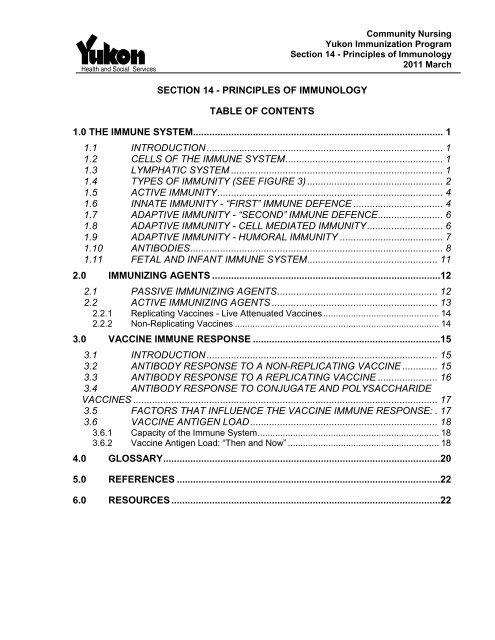
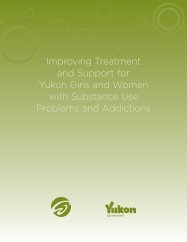
![Women and Alcohol: A women's health resource [2326.26 KB ]](https://img.yumpu.com/22340649/1/190x245/women-and-alcohol-a-womens-health-resource-232626-kb-.jpg?quality=85)
